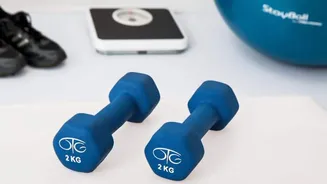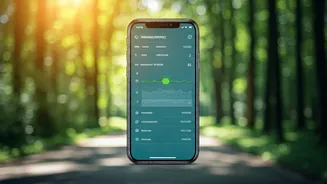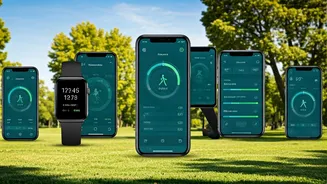Setting Fitness Goals
Selecting the right walking app is the initial step towards a successful fitness journey. There are various apps available, each designed with unique features
and functionalities. The primary goal is to identify an app that aligns seamlessly with individual fitness aspirations. These walking apps are designed to not only monitor steps but to provide an array of additional features, such as calorie counting, and progress tracking. Some apps allow users to create customized workout plans, including the capability of setting personal targets for distance, duration, or even the elevation changes desired for the walk. This level of customization ensures that the user's experience is tailored towards their specific needs, thereby providing an effective path toward achieving their fitness ambitions and goals.
Step Tracking and Accuracy
At the core of many walking apps lies step tracking, which provides the foundation for monitoring progress and staying motivated. Accuracy in step tracking is a crucial aspect, as it directly impacts the reliability of the collected data. The best apps use advanced algorithms to capture precise measurements, utilizing the built-in sensors on your smartphone. These technologies ensure that every step is counted accurately, irrespective of the walking speed or terrain. Besides this, some apps go a step further by integrating with wearable devices like smartwatches or fitness trackers. These devices give more detailed insights into movement, and the added benefit of heart rate monitoring provides users with a comprehensive overview of their overall health and fitness. By using accurate step tracking, walkers can rely on the data provided for informed decision-making and improvements in their fitness routines.
Motivation and Challenges
To keep users committed, many walking apps incorporate gamification. This can include rewarding users with badges, virtual trophies, or achievements for achieving milestones. The apps might also offer opportunities to participate in virtual challenges, encouraging users to compete with themselves or others. In addition, some apps foster a sense of community by allowing users to connect with friends and family. Social interaction boosts motivation and helps users stay engaged. These apps usually allow sharing of progress, participating in group challenges, or exchanging words of encouragement. The combination of personal progress tracking, rewards, and social engagement produces a very positive atmosphere, where users are able to stay motivated and keep up with their fitness journeys for the long haul. This comprehensive approach ensures that walking becomes an enjoyable and sustainable habit.
Customization and Flexibility
Customization is a key element that enables users to tailor their experience. Most apps provide settings for the user to define their personal goals, such as daily step counts, weekly mileage targets, or specific workout durations. This feature helps individuals to adjust their fitness plans to align with their schedules and preferences. Some apps offer additional features like personalized insights and recommendations based on the data collected. These may include suggestions for improving stride, adjusting workout intensity, or identifying opportunities for rest and recovery. For individuals with particular interests or preferences, there are apps that incorporate elements like virtual tours, audio guides, or music integration, to make walking more enjoyable. These options guarantee that users can create a personalized walking experience that supports their unique needs and keeps them motivated.
Detailed Performance Analysis
Advanced walking apps move beyond simple step tracking. They offer deep analysis of walking performance, and they are packed with features to help the users understand their movement patterns. These tools provide users with insights into various metrics, including average pace, distance covered, elevation gains, and active time. This is done through interactive charts, graphs, and visual representations, thereby making the data understandable and easy to interpret. The apps often allow users to track their progress over time, so they can see trends and identify improvements. Some apps integrate with other health and fitness platforms, thereby enabling users to consolidate all their health data in one location. This integration facilitates the creation of a comprehensive fitness profile, that provides a holistic understanding of their health and fitness journey, including how their walking activity interacts with other health parameters.
User-Friendly Interface Design
A well-designed interface is critical for an easy user experience. The ideal walking app should have a layout that's intuitive, making it easy for users to navigate and access features without confusion. The design should emphasize clarity, allowing users to quickly find the information they need, such as step counts, progress updates, and activity logs. The interface should also be visually appealing, using a color scheme and typography that is both pleasing and easy on the eyes. This not only enhances the user experience but also encourages more frequent use of the app. The design should also prioritize accessibility, so it is user-friendly to people of all ages and technical backgrounds. A user-friendly interface boosts the overall enjoyment of the app, ensuring that it becomes a valuable tool for tracking and improving fitness.
Integration and Compatibility
Integration with other devices and platforms improves the utility and scope of walking apps. Compatibility with wearable devices such as smartwatches and fitness trackers enables seamless data transfer, and gives users a more comprehensive view of their activity levels. This is especially helpful for people who wish to use their smartwatches for heart rate monitoring, sleep tracking, and other health data. Integration with other health and fitness platforms lets users synchronize their data across several platforms. This allows for a comprehensive overview of their health metrics in one central location. This integration ensures that users do not have to manually enter their data into various apps or manually track their progress, making it easier to keep a holistic view of health data.
Community and Social Features
Many walking apps are evolving into social platforms that allow users to connect, share their progress, and interact with other walkers. These social features can be a powerful motivator, providing a support system and sense of community that enhances the walking experience. Users can share their achievements, milestones, and challenges, and offer encouragement to each other. Many apps have leaderboards, where users can compete with friends or other app users, driving motivation. Participation in group challenges lets users work towards common goals. By providing a social environment, walking apps go beyond mere fitness trackers and become vibrant communities that encourage users to continue their fitness journeys and enjoy the benefits of regular walking.
Privacy and Security
Privacy and security are critical considerations. Users must always choose apps that prioritize the protection of their data. The app should have clear privacy policies that explain how the user's data will be used, stored, and protected. Look for apps that employ strong encryption protocols to protect user information from unauthorized access or breaches. Users should review the app's permission requests, and only grant access to the features necessary for its proper functionality. It is advisable to review the app's data security measures, including how it handles user data and complies with privacy regulations. By giving priority to these considerations, users can be confident that their personal data is protected and that they can enjoy the app's features with peace of mind.
Staying Consistent with Walking
Consistent walking is key to sustaining fitness goals. To establish a regular walking routine, begin with small, manageable targets. Try integrating short walks into your daily schedule. This could be a quick walk during a break at work, or a brisk stroll in the evening. As fitness levels improve, increase the duration, distance, and intensity of the walks. Varying the routes and activities helps to prevent boredom and keeps the experience engaging. Utilizing walking apps, setting goals, tracking progress, and participating in challenges boosts motivation. The social aspects, such as connecting with friends and family, and sharing your achievements on social media, make the process more enjoyable. These strategies make walking a long-lasting, beneficial habit that can significantly boost health and well-being.













